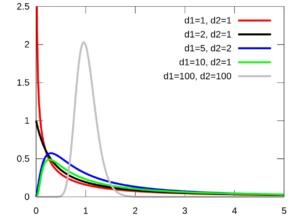< List of probability distributions < Ratio distribution

What is a ratio distribution?
A ratio distribution, also called a quotient distribution, is composed of the ratio of two random variables. If two random variables are X and Y, then their ratio distribution is X/Y. The random variables are usually independent and the probability distributions are usually known.
A ratio distribution is often used when probability distributions have intractable (difficult or impossible) solutions. For example, when a characteristic function is intractable, a joint characteristic function may be used instead. Many test statistics and estimators are formulated as ratio distributions [2].
Ratio distributions have applications in a diverse set of fields including biology, classification, economics, engineering, genetics, hydrology mathematics, medicine, physics, psychology, number theory, order statistics, and ranking and selection [3, 4]. For example, inventory ratios in economics, mass to energy ratios in nuclear physics and Mendelian inheritance ratios in genetics [5, 6]. Plant scientists use ratios of leaf area to total plant weight in the analysis of plant growth [7]. Other applications include calculating probabilities of computing error and outages [8], deterioration of rocket motors, static fatigue of ceramic components and fatigue failure of aircraft structures [9, 10]. The ratio of two correlated t-variates is found in economics and ranking and selection. It arises in Bayesian inference for some econometric models [11].
Common types of ratio distribution
While a ratio distribution can theoretically be obtained by dividing any two random variables, some ratio distributions are fairly common:
- The beta prime distribution is the ratio of two independent chi-squared random variates.
- The Cauchy distribution (also called the normal ratio distribution) is the ratio of two normal random variates with zero mean.
- The F-distribution is the ratio of two independent chi-square random variables. It is sometimes called the variance ratio distribution.
- The t-distribution can be obtained by dividing a normal random variable by an independent chi-distributed random variable.
Numerical procedures are available in the literature and statistical software packages for calculating ratio distributions when the random variables follow binomial, Cauchy or uniform distributions. Other ratios will be relatively slow to compute.
References
[1] IkamusumeFan, CC BY-SA 4.0 https://creativecommons.org/licenses/by-sa/4.0, via Wikimedia Commons
[2] Broda, S. & Kan, R. “On Distributions of Ratios,” Biometrika (2015). Retrieved September 14, 2023 from: https://www-2.rotman.utoronto.ca/~kan/papers/ratios.pdf
[3] S. Nadarajah and D. Choi, “Arnold and Strauss’s bivariate exponential distribution products and ratios,” New Zealand Journal of Mathematics, vol. 35, pp. 189–199, 2006. Google Scholar.
[4] M. Shakil and B. M. G. Kibria, “Exact distribution of the ratio of gamma and Rayleigh random variables,” Pakistan Journal of Statistics and Operation Research, vol. 2, no. 2, pp. 87–98, 2006.
[5] M. M. Ali, M. Pal, and J. Woo, “On the ratio of inverted gamma variates,” Austrian Journal of Statistic, vol. 36, no. 2, pp. 153–159, 2007. Google Scholar.
[6] L. Idrizi, “On the product and ratio of Pareto and Kumaraswamy random variables,” Mathematical Theory and Modeling, vol. 4, no. 3, pp. 136–146, 2014. Google Scholar.
[7] Poorter, H, Garnier, E: Plant growth analysis: an evaluation of experimental design and computational methods. J. Exp. Bot. 47(9), 1343–1351 (1996).
[8] S. Park, “On the distribution functions of ratios involving Gaussian random variables,” ETRI Journal, vol. 32, no. 6, 2010.
[9] S. Nadarajah and S. Kotz, “On the product and ratio of t and Bessel random variables,” Bulletin of the Institute of Mathematics Academia Sinica, vol. 2, no. 1, pp. 55–66, 2007.
[10] T. Pham-Gia and N. Turkkan, “Operations on the generalized-f variables and applications,” Statistics, vol. 36, no. 3, pp. 195–209, 2002. Google Scholar.
[11] S. James Press. “The T-Ratio Distribution.” Journal of the American Statistical Association, vol. 64, no. 325, 1969, pp. 242–52. JSTOR, https://doi.org/10.2307/2283732. Accessed 14 Sept. 2023.